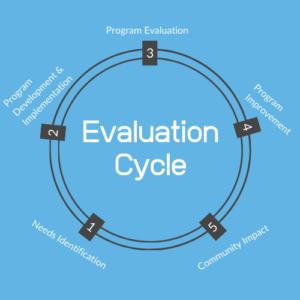
So what does evaluation look like? Programs are constantly somewhere in the evaluation process. We’re always seeking input from our system partners and always checking to make sure we’re on track for helping families. Here’s an example of how we used our partner-focused system to identify and develop a proactive approach to an issue for Wake families.
Step 1: Needs Identified | Wake Connections, WCSS’s one-stop coordinated intake and referral system that connects families with high quality home-based and group programs, had a long waiting list last year. As they became aware of this growing significant need for services, they listened to their partners. The partners were also seeing the need, yet they had a limited capacity to take on more families. WCSS backed up these observations with data that showed families on the waiting list often had need for multiple services.
Step 2: Program Development & Implementation | How can the issue of the long wait list be addressed? For a different type of problem, like too many open program slots or inefficiency in service, other solutions could have been proposed. In this case, it was recommended to create a request for proposals (RFP) for agencies to take on more capacity to serve waiting families.
Step 3: Program Evaluation | The development of the RFP included use of community indicators to ensure the parameters of services requested would meet actual community needs. In this case, numbers around Child Abuse and Prevention were used. Looking at data gathered from Wake Connections, including documentation of how programs would proceed, a logic model was created, and sustainability was a big factor in consideration. WCSS publicized the RFP, local agencies applied, and a non-conflicted committee of volunteers (the Allocations Committee) reviewed the proposals. The committee made the recommendation to add one program (Hope at Home from Hope Family Services) and expand another (HIPPY) to meet the need for services, especially for three-year-olds. Beginning in Fall 2019, Hope at Home and HIPPY officially began addressing the over-crowded Wake Connections wait list.
Step 4: Program Improvement | This step includes the quality assurance aspects of evaluation. WCSS will look at how Hope at Home and HIPPY are meeting their goals of expanding access to home visiting and group services and relieving the Wake Connections waiting list for children birth to three.
Step 5: Community Impact | Assessment of community impact is broad and ongoing through quarterly reporting by programs. Strong family support is needed, addressing families’ needs directly, and this reporting allows partners to document how they do so.
At all points in the evaluation process, the input of and collaboration with system partners is needed to ensure success and community fidelity. Like a wheel, WCSS programs cycle through these stages throughout their lifetime, constantly gauging effectiveness and impact for Wake’s families.



